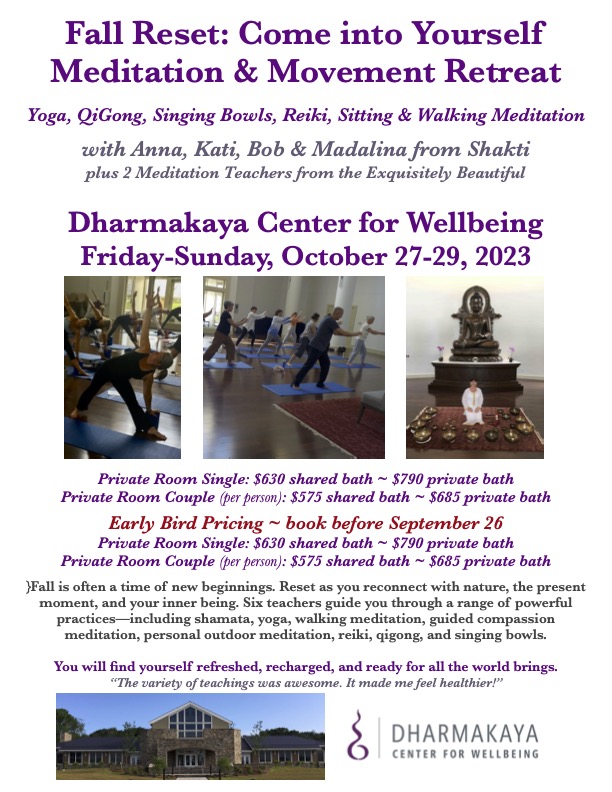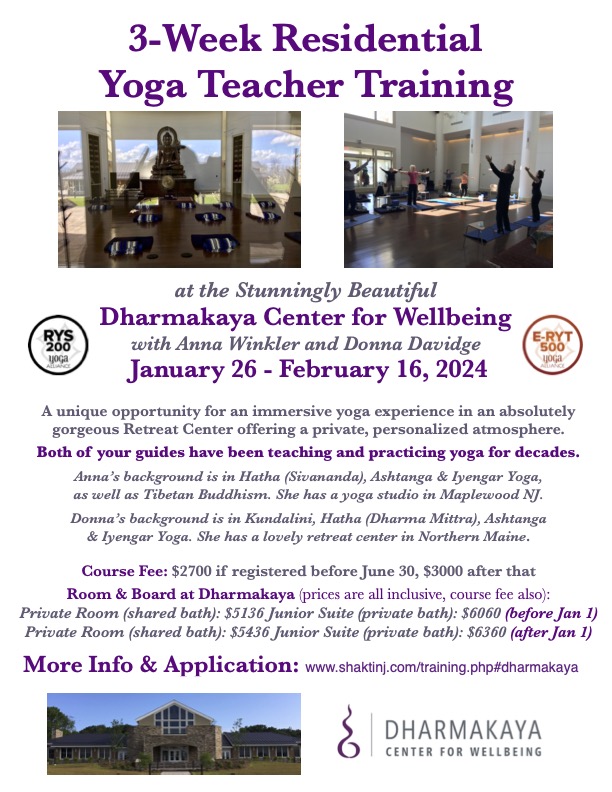About Yoga
Yoga means union, of body, mind, soul and individual with All. It is both the path & the goal. It is not a religion, but a philosophy and a practice. Whatever your belief system or religious affilation, yoga can and will enhance the depth of your understanding and experience of that.
THE FOUR MAIN PATHS OF YOGA
Each path is suited to a different temperament or approach to life. All the paths ultimately lead to the same destination ~ Union with the Divine. Integrating the lessons of each path leads to True Wisdom.
Karma Yoga ~ Path of Action
Chosen primarily by those of an outgoing nature, this path purifies the heart by teaching us to act selflessly, without thought of gain or reward. By detaching oneself from the fruits of one’s actions and offering them to the Divine, the ego is sublimated. This is the central teaching of the Bhagavad Gita.
~ Click here to learn more about Karma Yoga and selfless service opportunities here at Shakti.
Bhakti Yoga ~ Path of Devotion
Said to be the surest, safest, quickest way to “God-Realization,” this path appeals to those of an emotional nature. Motivated chiefly by the power of love, Bhakti Yogis see the Divine as the embodiment of love. Through prayer, worship and ritual one surrenders oneself to the Divine, channeling and transmuting emotions into unconditional love or devotion. Chanting and singing praises of the Divine form a substantial portion of Bhakti Yoga.
Raja Yoga – Scientific Path of Physical & Mental Mastery
Called the “Royal Road,” this path offers a comprehensive method for calming the turbid thought waves by transmuting our mental and physical energy into spiritual energy. Also called Ashtanga Yoga, referring to Patanjali’s 8 Limbs of Raja Yoga, the chief practice here is meditation. It also includes all other practices that help one to explore and master body, senses, energy and mind. The Hatha Yogi uses asanas, pranayama and kriyas to explore and master the physical body and subtle energy called Prana. Meditation comes naturally to one who has mastered the physical body, senses and subtle energies.
Jnana Yoga – Path of Wisdom
Called the “Razor’s Edge,” this most difficult of paths requires tremendous strength of will and intellect. Using the philosophy of Vedanta, the mind inquires into its own nature. Just as we perceive the space inside and outside of a glass as different, so too we see ourselves as separate from the Divine. Jnana Yoga leads the inquirer to experience unity with the Divine by breaking the glass and dissolving the veils of ignorance and separation. It is best to have integrated the lessons of the other paths first, for without selflessness, devotion and strength and awareness in body and mind, the search for self-realization can become idle speculation or egoistic argumentation.
THE EIGHT LIMBS OF RAJA YOGA
Compiled by the Sage Patanjali Maharishi in the Yoga Sutras, the Eight Limbs are a progressive series of steps or disciplines which purify the body, speech and mind, ultimately leading the Yoga to enlightenment.
Yama – Restraints (Don’ts) - 5 moral injunctions, aimed at destroying the lower nature.
- Ahimsa – non-violence in thought, word and deed
- Satya – truthfulness in though, word and deed
- Brahmacharya – moderation (control of senses, sexual energy) in thought, word and deed
- Asteya –non-stealing (taking more than is needed or offered) in thought, word and deed
- Aparigraha – non-coveting (not desiring what belongs to another) thought, word and deed
Niyama – Observances (Dos) – 5 ethical precepts to encourage the higher nature.
- Saucha – purity – internal and external cleanliness
- Santosha – contentment
- Tapas – heat, austerity
- Swadhyaya – study of sacred texts and study of Self
- Ishwara Pranidhana – constantly living with an awareness of the Divine (surrender to the Divine Will)
Asana – Yoga postures (literally means steady comfortable seat or pose)
Pranayama – mastery of the breath, storing and increasing the subtle energy in the body called Prana. Asana and Pranayama form the subdivision of Raja Yoga known as Hatha Yoga.
Pratyahara – withdrawal of the senses in order to observe the mind. Gateway to the internal practices.
Dharana – concentration. The last 3 steps constitute the internal practices of Raja Yoga. When Dharana is achieved, it leads to the next step:
Dhyana - meditation. A state of consciousness (like sleep) where there is complete absorption between the observer, the act of observing and that which is observed. When mastered, Dhyana leads to the last step.
Samadhi – super-conscious state. In Samadhi, non-duality or oneness is experienced for an extended period of time. This is the deepest and highest state of consciousness, where body and mind have been transcended, and the Yogi is one with the Divine.
MORE ABOUT THE YAMAS
Ahimsa
Ahimsa is the first of the five dictates of the Yamas (rules of moral conduct), which is the first of the eight limbs (Ashtanga) of RajaYoga from Patanjali’s Raja Yoga Sutras (Sutra means thread and is a short, pithy statement, rich with meaning).
“By abiding in nonviolence, ones presence creates an atmosphere in which hostility ceases.” For one who increasingly experiences the natural inner peace of a non-harming attitude, others give up their hostilities or aggression in return. It is an automatic process, which we have all felt when in the presence of a truly non-violent person.
~ Interpretation of Sutra #2-35 of Raja Yoga Sutras
Non-harming does not mean love. Non-harming and love are two different things. Ahimsa is not a practice whereby you are feeling the drive to harm others and you practice love to stop that. Rather, the first step is to focus on the cessation of harming at the levels of action, speech, and thought. Then, the natural love can come shining through. This has extremely practical application in daily life. Trying to directly cultivate love for a person you dislike might be extremely difficult, whereas working on letting go of the negative is more direct and immediate.
~ Excerpts from a discourse with Swami Rama and Swami Sivananda.
 Ahimsa or non-injury, of course, implies non-killing. But, non-injury is not merely non-killing. In its comprehensive meaning, Ahimsa or non-injury means entire abstinence from causing any pain or harm whatsoever to any living creature, either by thought, word, or deed. Non-injury requires a harmless mind, mouth, and hand.
Ahimsa or non-injury, of course, implies non-killing. But, non-injury is not merely non-killing. In its comprehensive meaning, Ahimsa or non-injury means entire abstinence from causing any pain or harm whatsoever to any living creature, either by thought, word, or deed. Non-injury requires a harmless mind, mouth, and hand.
Ahimsa is not mere negative non-injury. It is positive, cosmic love. It is the development of a mental attitude in which hatred is replaced by love. Ahimsa is true sacrifice. Ahimsa is forgiveness. Ahimsa is Shakti (power). Ahimsa is true strength.
Practice of Ahimsa develops love. Ahimsa is another name for truth or love. Ahimsa is universal love. It is pure love. It is divine Prem. Where there is love, there you will find Ahimsa. Where there is Ahimsa, there you will find love and selfless service. They all go together.
How many ways can you practice Ahimsa throughout the day? Practice Ahimsa for yourself as well.
~ Written by former Shakti Teacher & Prana Yoga Studio owner (in Pottersville, NJ), Al Macchi.
Satya
"Satya" is one of the five Yamas, or moral codes / restraints of Raja Yoga. The Yamas deal with how we interact with the outside world and our relationships. By learning to abide by the yamas, we can become less troubled by our external situations (making our brain chatter die down) and can become more peaceful within.
The simplest definition of Satya is truthfulness.
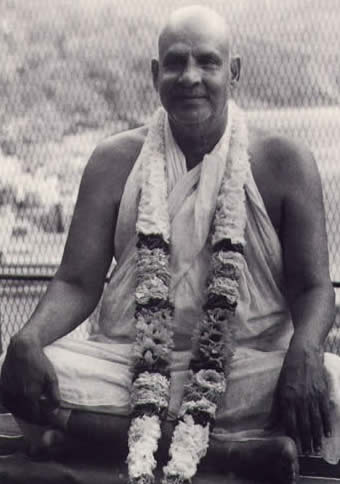 Swami Sivananda says, "God is truth. He can be realised by speaking truth and observing truth in thought, word and deed. Truthfulness, equality, self-control, absence of envious emulation, forgiveness, modesty, endurance, absence of jealousy, charity, thoughtfulness, disinterested philanthropy, self-possession, and unceasing and compassionate harmlessness, are the thirteen
Swami Sivananda says, "God is truth. He can be realised by speaking truth and observing truth in thought, word and deed. Truthfulness, equality, self-control, absence of envious emulation, forgiveness, modesty, endurance, absence of jealousy, charity, thoughtfulness, disinterested philanthropy, self-possession, and unceasing and compassionate harmlessness, are the thirteen
forms of truth."
Satya is telling the truth, not pretending or exaggerating, but it is much more than that. It also means being truthful in actions, if you have truth behind what you do and who you are. For example, we can lie to ourselves financially, by buying things that we truly cannot afford, or by putting off the essentials to purchase the non-essentials. Satya means being truthful even in your thoughts! How many times do we get mad at ourselves or someone else and think bad things that we don't really mean? We can also take this back to satya and trying to be truthful and honest with ourselves.
We can also be aware that sometimes, we as human beings will blind ourselves into believing that we did the right thing when we really did something foolish, and this is another type of non-truth. We can be lying to ourselves and not even know it, which is why being present and aware is so important in this practice.
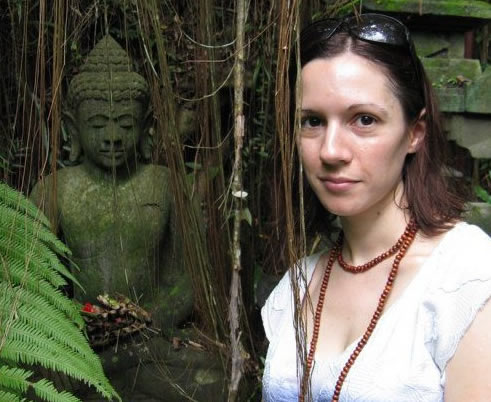 The layers of this Yama can be pulled back even more. In order to be truthful, one must be able to see the external world in it's true state, and that's where it can get complicated. Separating reality from what we perceive as reality can be two different things and it takes reaching the higher mind (consciousness) to interpret the difference. Thus, satya encourages us to seek out the truth. Some great swamis even believe that in certain limited situations, that telling a small lie that will ultimately bring a great amount of good, is the truth. But we need to ground ourselves (meditate) first, decipher what is truly going on, and only then can we make truthful decisions.
The layers of this Yama can be pulled back even more. In order to be truthful, one must be able to see the external world in it's true state, and that's where it can get complicated. Separating reality from what we perceive as reality can be two different things and it takes reaching the higher mind (consciousness) to interpret the difference. Thus, satya encourages us to seek out the truth. Some great swamis even believe that in certain limited situations, that telling a small lie that will ultimately bring a great amount of good, is the truth. But we need to ground ourselves (meditate) first, decipher what is truly going on, and only then can we make truthful decisions.
"Speaking truth is the most important qualification of a Yogin. Truth is righteousness... Truth stands even when there is no public support." ~ Swami Sivananda
~ Written by Laurie Albetta, Shakti Volunteer and Sivananda TTC graduate
YOGA IS ABOUT FREEDOM
The teachings of yoga are about freeing you.
The disciplines of yoga are about living free while in this body.
Living the yamas of yoga frees you within your social relationships.
The niyamas cultivate your inner freedom by placing you on the path of transformation.
Asana develops freedom within living in your body.
And pranayama expands the freedom that comes with breath.
Pratyahara frees you from the addiction to your senses and your reaction to them.
Dharana offers the freedom of a clear, one-pointed mind.
And dhyana reveals freedom as your natural state.
Finally, samadhi is the expression, the abiding within, of your true state of being free.
Make this a year of establishing the essence of your yoga practice as spiritual freedom.
Explore all the ways in which the healing, transformation, and illumination of yoga ARE
the journey of freedom.
ON THE BODY
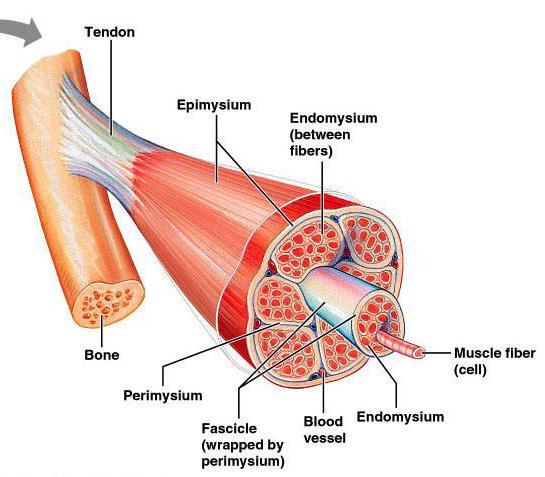 Connective tissues form a continuous netlike framework throughout the body. Connective tissue consists largely of a fluid matrix (ground substance) and collagen fibers that support, bind, and connect the wide range of body structures. Depending on its consistency and the varying proportions of fluid to fibers, wide arrays of connective tissues are formed. Some examples are the fluid intercellular environment, the superficial fascia just below the skin, the fascia of the muscles, the tendons and ligaments, the tough cartilage, and even bone.
Connective tissues form a continuous netlike framework throughout the body. Connective tissue consists largely of a fluid matrix (ground substance) and collagen fibers that support, bind, and connect the wide range of body structures. Depending on its consistency and the varying proportions of fluid to fibers, wide arrays of connective tissues are formed. Some examples are the fluid intercellular environment, the superficial fascia just below the skin, the fascia of the muscles, the tendons and ligaments, the tough cartilage, and even bone.
ON THE NATURE OF MEDITATION & TIME
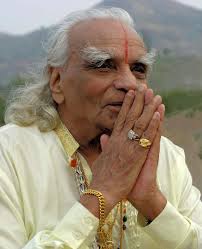 A person who meditates is free from time. Probably many of you do not know what time is. We all know the word 'moment'. The moment does not move. The moment is stable, but our mind does not see the moment - it only sees the movement created by the succession of moments. We see the succession of moments like the spokes of a wheel. The moment is the hub of the wheel and the movement of the moments is the spokes. In meditation, the person who has mature intelligence lives in the moment and will not be caught in the movement of moments.
A person who meditates is free from time. Probably many of you do not know what time is. We all know the word 'moment'. The moment does not move. The moment is stable, but our mind does not see the moment - it only sees the movement created by the succession of moments. We see the succession of moments like the spokes of a wheel. The moment is the hub of the wheel and the movement of the moments is the spokes. In meditation, the person who has mature intelligence lives in the moment and will not be caught in the movement of moments.
The movement of moments is seen in the waking thoughts, the rising thoughts and restrained thoughts. The person of mature intellect tries to live in the moment without being caught in the movement of rising and fading thoughts. The movement is the past and future; the moment is the present.
The practitioner cultures his mind, his intelligence and his consciousness to live in the moment, and as each moment moves on to the next, he goes with the moment but not with the movement.
That is meditation. ~ B.K.S. Iyengar, The Tree of Yoga
ON THE MIND
The body possesses many Channels (shrotamsi) through which nutrients and wastes move. Though innumerable, fourteen of these channels are primary. The fourteenth channel, the Channel of Mind, pervades the entire body; the body is in a sense the mind's special channel. There is nowhere in the body mind cannot and does not go.
~ Robert Svoboda, Tao & Dharma: Chinese Medicine and Ayurveda

A FRESH ATTITUDE
A fresh attitude starts to happen when we look to see that yesterday was yesterday, and now it is gone;
today is today and now it is new. It is like that - every hour, every minute is changing.
If we stop observing change, then we stop seeing everything as new. ~ Dzigar Kongtrul Rimpoche
ON LOVING KINDNESS
Peace between countries must rest on the solid foundation of love between individuals. ~ Mahatma Gandhi
ON THE TAO
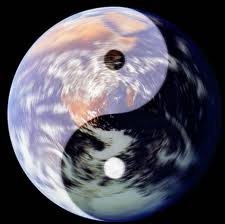 The tao that can be told is not the eternal Tao.
The tao that can be told is not the eternal Tao.
The name that can be named is not the eternal Name.
The unnamable is the eternally real.
Naming is the origin of particular things.
Free from desire, you realise the mystery.
Caught in desire, you see only the manifestations.
Yet mystery and manifestations arise from the same source.
This source is called darkness.
Darkness within darkness.
The gateway to all understanding.
Practice not-doing, and everything will fall into place.
The Tao is like a well: used but never used up. It is like the eternal void: filled with infinite possibilities. It is hidden but always present. I don't know who gave birth to it.
It is older than God.
Tao Te Ching, translated by Stephen Mitchell
Shakti Merch!
 Tanks, Ts, Dresses & Hoodies!!
|


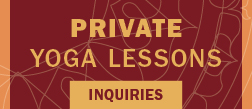



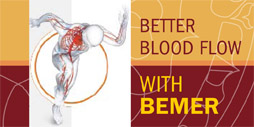


.jpg)
.jpg)
